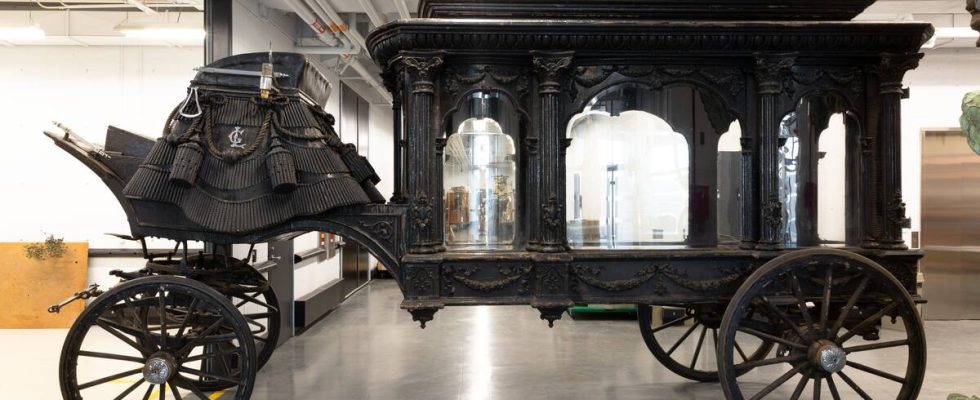For 80 years, this baroque landau carried the coffins of great dignitaries through the streets of Quebec to their final resting places. Each time you go out, it’s an event: the crowds flock to see the finely crafted hearse and its large black horses pass by.
But over the years, it becomes more and more difficult to organize this ritual, as André Lépine explains to the anthropologist Brigitte Garneau about the last outing of the hearse for the funeral of Rosaire Bédard in 1980:
“It took 90 hours of work […]. We had to find the bridles for the horses […]. And renting the horses was something, you had to bring them in; horses that were used to walking in team, as the saying goes. […] And insurance. […] We’re talking about funerals costing around $30,000.”
Even then, this equestrian heritage was fading. Yet just a century before, it was the golden age of large horse-drawn hearses.
The horse-drawn hearse during its last outing on the occasion of the funeral of merchant Rosaire Bédard on September 26, 1980. The landau was exhibited in the window of the Lépine funeral home on Saint-Vallier Street West in Lower Town of Quebec until in 1989, then stored in a barn belonging to the Lépine family in Tewkesbury until its acquisition by the Musée de la civilization in 2019. Source: Société historique de Charlesbourg.
Source: Charlesbourg Historical Society
At the funeral of yesteryear
“The little hearses, hearses, hearses of our grandfathers which jolted along the road,” sings Georges Brassens.
From long wakes at home to coffins carried on the shoulder to the cemetery; hearses make their entry into the funeral ritual at the beginning of the 19e century in Quebec.
According to a regulation of 1684, it is obligatory to transport the coffin on foot to the cemetery, which could be an ordeal for the bereaved family living far from the burial site. This tradition continued in certain rural regions, notably in Beauce, until the beginning of the 20e century.
Despite the resistance of the bishops, certain parish factories, notably in Saint-Augustin-de-Portneuf in 1805, acquired the first small horse-drawn hearses.
With the emergence of professions linked to funeral directors in the mid-19e century, entrepreneurs took over from factories, avoiding the purchase of cars.
In 1845, Germain Lépine acquired his first hearses. At the height of his activities, he had 10 mortuary carts, including a small white neo-Gothic pram dedicated to children and a black hearse with a neoclassical-style oval window.
In 1898, employees of Maison Lépine made a catafalque hearse from scratch for the funeral of Cardinal Elzéar-Alexandre Taschereau, using countless hours of work. This experience convinced the Lépine family to acquire a real ceremonial hearse in 1900 for special occasions.
The Victorian era and glorified mourning
At 19e century, death does not spare the most humble nor the most powerful. The premature death of her husband Albert in 1861 from typhoid fever plunged the Queen of England into a long period of mourning which lasted 40 years.
“As the only woman of power in the public space, Victoria certainly influenced her contemporaries to grant a particular attachment to the deceased. This is reflected in mourning practices which glorify the memory of the deceased. Grand funerals are one of its manifestations,” explains historian Louise Lainesse, whose doctoral research focuses on this period in particular.

The funeral of Cardinal Louis-Nazaire Bégin in July 1925. With its cross, the Lépine horse-drawn carriage reached an impressive height of 4.26 m. Removable, the cross must be removed from its base to pass under the tram wires until 1948. It can also be removed in the event of funerals of people from other religious faiths.
Source: Musée de la civilization, archives of the Séminaire de Québec
The legacy of the Lépine family
Over five generations, the Lépine family has accompanied bereaved families with real compassion. During major disasters, from fires to shipwrecks and economic crises, the funeral home came to the aid of victims’ families and offered free funerals to those most in need.
At the turn of the 20e century, there are several hundred horse-drawn hearses, reflecting the most refined work of craftsmen from here and elsewhere. Today, only about fifteen remain, including the remarkable ceremonial hearse of Maison Lépine which has left its mark on the history of Quebec.
